Mid-February finally arrived, and we were off sailing in the Bay Of Islands again, about 100 mles north of where we live in New Zealand.
This was to be our second sailing trip in this area, and we had been looking forward to this day for a year. Last February we also came north. We had a couple of days sailing around Whangaroa Harbour, and then nine days cruising around the BOI. That was a great trip, with hot sunny days and beautiful new areas for us to explore and we were looking forward to more of the same this year.
The drive north seemed to take forever, and a visit to friends on the way meant it was the middle of the afternoon before our Pathfinder Varuna was ready to launch at Opua. With about 15kts of NW breeze gusting straight up the estuary, we decided we would motor a couple of miles to a sheltered bay near Russell for the night. A SW change was predicted for the morning which would be perfect for a leisurely trip down to the islands the next day.
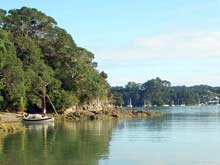 |
We found a rocky little bay, and anchored for the night just off a small beach. |
| It was a very quiet and peaceful scene, bathed in the late afternoon sunshine. As the sun set we spotted a moa in the bush on a nearby point. |
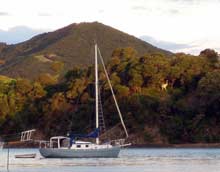 |
Next morning we were away under mizzen and jib, lured towards nearby Russell by thoughts of getting our last real coffee for a while. As we sailed through a narrow gap into historic Kororareka Bay, the wind had steadied a bit so we made a quick change to the plan, hoisted the main and set off towards the open sea and the islands about 10 miles away. It was a quiet day, but we made steady progress, and by lunch time we were pulling into a beautiful bay on Moturua Island for that long overdue (instant) coffee.
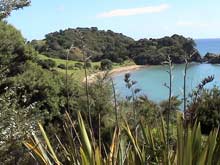 |
Waiwhapuku Bay, Moturua Island |
Later in the day we moved down to the next bay, one of our favourite spots from last year, where we planned to spend the night.
The description in the cruising guide reads:
"Otupoho Bay - a tiny cove suitable for shallow draft vessels, but a great spot if you can get your boat in there". Designed for Pathfinders :-)
We swam and snorkled in the warm water in the late afternoon sunshine. As the day died a beautiful old gaff rigged boat sailed into the bay to join us for the night.
That night we drifted off to sleep on the still water listening to moreporks calling around the bay, and a kiwi screeching up in the bush clad hills.
Next morning we met Bob, the owner of the mullet boat that we had watched tacking into the mouth of the bay. He stopped for a chat as he rowed passed in his quaint little dinghy, resplendant with pohutukawa root knees.
| "Cora", Bob's mullet boat turned out to have quite a history. Bob has restored her to her former glory, she really looks a picture. |
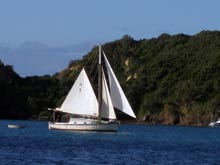 |
'Cora' turned out to have quite a history; she was the last boat built & sold by Logan Brothers from their Mechanics Bay yard in 1910, and at 28 feet she is about as big as mullet boats get. She was owned for some time in the 1930's by Charlie Hanson, the hermit resident on Moturekareka Island in the Hauraki Gulf, one of our favorite anchorages in "home" waters.
She had been converted to a motor launch when Bob bought her, and had had her centreboard replaced with a long keel. Bob has restored her to her former glory, she really looks a picture.
The forecasters promised us a change to Easterly winds for the next couple of days, perfect for a sail up the Cape Brett peninsula. This is part of the Bay of Islands we did not visit last year, and the closest thing to 'open ocean' sailing for us yet. The peninsula forms the eastern boundary of the bay and is exposed to the open South Pacific ocean to the north and west. At it's tip is Piercy Island and the famous "Hole in the Rock". If you set a course west from there, the next landfall is half a world away in South America.
We left in very light SW conditions, and called in for water at the DOC camping ground at Cable Bay. We motored through the Albert Channel and around to take a look at Oke Bay. It was a grey day, and the steep cliffs and bush covered hills of the peninsula seemed to brood over the landscape. We cruised around the shore of Oke Bay looking for sheltered spots where we might spend the night. There is a lovely white sandy beach at the head of the bay, and there were a couple of yachts anchored there. We didn't stop, the wind was at last showing signs of building and we motor-sailed up the next three miles of coast to Deep-water Cove. This large bay is aptly named, we stopped for lunch in a little inlet tucked in a corner which is the only water here shallow enough for anchoring. The water teemed with fish, and a seagull joined us aboard for while.
Along the northern shoreline of the bay an ex-NZ Navy frigate was scuttled last year to form a diving reef, we searched the depths in vain for a glimpse as we passed over the site.
With the day getting greyer and windier, we headed off again toward the cape. Sailing in a freshening SW breeze, we soon reached the end of the land. A lighthouse is perched high on the last slope of the peninsula; a keepers house much lower down appears to have been built in a rocky niche carved into the rock, presumably to give it a chance in the ferocious storms that sweep through here on occasions.
Piercy Island and the 'Hole in the Rock' are one of the 'must-see' sights for the many tourists who visit this part of NZ.
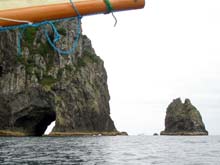 |
The large launch anchored between Piercy and Dog Islands gives the picture some scale. |
Out past Piercy Island we decided we would leave South America for another time, so turned back and retraced our steps. The wind was now steady and had swung around to the NE and it was a beautiful sail back down the length of the peninsula to Oke Bay. We anchored just off the beach and went ashore for a while to stretch our legs and have a swim. We settled in for the night in the sheltered NW corner of the bay. As the day died, the grey weather and forbidding landscape gave the place a sombre air. The sporadic dull booming of surf in caves at the base of the cliffs opposite only added to the gothic atmosphere.
Early next morning it was all shrouded in misty drizzle and a keen wind. At about 9am the sun broke through the murk and gave the day a whole new look. The weather cleared rapidly, we sailed around to Rawhiti in a steady breeze to check out (much exagerated) rumours of a store there.
I managed to scrounge a couple of piper (for bait) from an old gent netting on the beach, and then we headed towards the western side of Urupukapuka Island where there are several large sheltered bays. We were ready for a nice quiet day, and knew we could find one here. By now the day was brilliantly sunny, and the sail across to the island was stunning. As you get near the channel between Poroporo Island and Urupukapuka Island, the deep blue water of the Albert Channel is suddenly gone, and the passage becomes shallow with a white sandy bottom. We saw a shark and several stingrays here as we sailed towards Otehei Bay. There is some tourist accomodation and facilities ashore here so we called in to have a look. We scored a pub lunch, a cold beer and a couple of bags of ice for the chilly-bins which made the visit seem very worthwhile.
We then sailed a bit further around the coast of the island, to a sheltered sandy bay nearby. Anchored just off the beach, we spent a lazy day enjoying the idyllic spot.
When we had anchored in the same bay last year, we had been driven out by wasps that invaded the boat and generally made a nuisance of themselves. There were a few around this year and in the late afternoon I walked around the bushline above the bay and found their nest. It was a hole in the ground about 4 inches in diameter, and there were hundreds of wasps flying in and out every minute. I paid them another visit after dark, and dealt to them with a little bottle of petrol.
For the last few days the weather gurus had been predicting a large low pressure system moving down on the country from the north, and this weather pattern sometimes injects nasty tropical storms into our summers. This one didn't look too bad to my untrained eye, but we started thinking about where we might shelter if it did turn nasty.
| At dusk the wind started to rise again, we spent a comfortable night at anchor in our sheltered bay. |
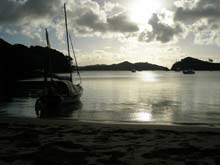 |
Another lazy day was spent exploring around the bays and nearby islands. We had another late afternoon swim in the warm water, but after dark a cold wind got up.
The following day dawned grey and gusty. The forecast for the next couple of days was now looking a bit grim. The approaching depression had deepened and was bearing down on the country from the NW. The forecaster was now promising NW winds of 35kts gusting to 45 for the next afternoon.
Later in the day we met Bob Denham on the beach, he had sailed into the bay in his charter yacht Woodwind. He has previously owned (built?) both a Navigator and a Pathfinder. He has now seen the error of his ways, and has nearly completed building himself a replacement Pathfinder.
We went back to the sheltered little corner where we had spent the previous night. It was low tide so I took a swim and made sure the anchor was well dug in to the firm sandy bottom. We spent a long uncomfortable night with huge gusts of wind almost flattening the tent from time to time, and the boat turning circles on the anchor. We were sheltered from the stong wind sweeping over the island, but the slopes above and around the bay kept the wind swirling at sea level, mini williwaws maybe. The first of several heavy showers of rain woke me in the wee small hours. At dawn I was gently woken when a fine mist of spray landed on my face. A second or two later it happened again, before the third time I was fully awake, and looking up at a another drop of water about to fall from the tent pole onto the top of the centrecase beside me. I then realised that the foot of my bed was not feeling as dry as I would have liked. A quick inspection confirmed that our tent was not up to repelling the torrential rain that was now falling. The day was starting to look like it might be a long one. The forecast was even worse now, with gusts up to 50 knots for the late morning. The Bay of Islands "now casting" was already reporting a 40 knot average windspeed.
Time for plan B.
High tide was at 9:30, we motored across to the far end of a neighbouring bay which looked a little more sheltered and let Varuna dry out on the sandy beach as the tide receeded.
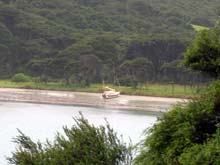 |
We motored across to the far end of a neighbouring bay which looked a little more sheltered and let Varuna dry out on the sandy beach as the tide receeded. |
The prospect of sitting high-and-dry for the next 10 hours or so until the tide reached us again seemed much better than swinging around on the end of the anchor. It also gave us the option to spend time ashore, and with the likelyhood of a two or three day stay ahead of us here, this was also appealing. The next couple of hours we spent making the tent as waterproof as we could. While packing the boat for this trip I had contemplated leaving a couple of cheap plastic tarpaulins at home; we had taken them away with us on several earlier trips and never used them. Good sense prevailed and I packed them in. We were glad to have them now; along with a survival blanket, some rope, duct tape etc we soon had the tent reasonably watertight.
| Not pretty, but effective. |
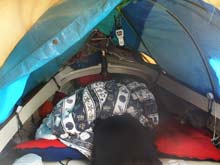 |
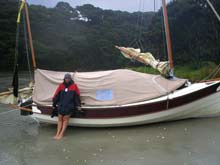 |
It was a miserable day, the wind was still howling over the island, the rain was pelting down, pretty much everything was wet. |
We put on our wet weather jackets and went for a walk, abandoning Varuna to her fate for a while.
A track took us through the bush and then up a ridge line towards the exposed north coast of the island. It was wild up there. We looked down on a huge swell pounding into the reefs and channel between the islands. The track led us right out to a magnificent cliff-top site. This had two-hundred foot cliffs all around it, the wind was carrying spray up and over these cliffs from the sea below.
After a couple of hours tramping in those conditions, Varuna felt like a cosy and inviting home again when we got back.
At low tide I set the anchor out in the bay to make it easier to refloat later that night. When we did, at about 9pm, the wind was still blowing a gale, and it was raining heavily. We put Varuna back on the beach again just after high tide, and crawled into our damp beds. It was another wild night, with huge gusts of wind blasting us. We lay there dozing fitfully in the lulls, in the gusts we each grabbed an end of the tent batten, and held it down on the boat. The option of sitting on a beach is invaluable when conditions get really bad, it would have been a very worrying and uncomfortable night afloat.
Varuna floated off gently the next morning, earlier than I expected on a very high tide. The wind had dropped a bit, and there were now some breaks in the rain which had been falling in torrents most of the night. We sorted out the boat a bit, and started trying to dry our bedding. Later we went out walking again, in clearing rain and visited some of the other bays. I checked out the wasp nest on the way, mission accomplished, no activity there at all.
| We checked out a couple of other sheltered spots, and decided we already had the best of them. |
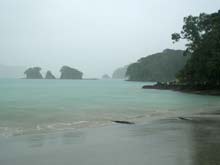 |
Nearby Paradise Bay was exposed to some swell, with large waves sweeping the beach. We checked out a couple of other sheltered spots, and decided we already had the best of them.
The tracks through the bush were like running streams, and the beaches were covered in weed and other debris. It was still very windy, but the weather was definitly improving. As far as we could see, we had the island to ourselves, there were no boats in any of the bays we visited.
We both slept well in our damp beds, and next morning woke to watery sunshine and a calm day. A clothesline strung up between nearby trees soon held all our wet gear, drying in the gentle breeze. The day quickly improved and with the sunshine came company again. We hadn't seen another person for a couple of days. Now several boats arrived in the bay.
With everything dry again, we packed up after lunch and set off to exploring some of the nearby mainland coast. We ended up in a little sheltered corner in Parekura Bay, and settled in for the night. I was woken during the night when the wind swung back to SW, and some waves started us rocking a little. By morning the SW was picking up, we set off to sail back down the coast to Russell for some fresh supplies. Ther wind quickly rose to near the promised 20 knots. We had a most enjoyable sail along the coast, stopping at one point to put a reef in the main, and then shaking it out again half an hour later. One long reach saw us down near Moturoa Island, and then we tacked up the estuary to Russell. We were there by lunchtime, left Varuna anchored off the beach and found a cafe for lunch. We got rid of the rubbish, stocked up with food and fuel and then sailed back out toward the islands again.
Another couple of days was spent sailing, swimming and relaxing in calm sunny weather before we packed up the tent for the last time and headed back towards Opua and home. We had been away for 12 days, and the home comforts were starting to look pretty good. It had been another excellent trip.
The Bay of Islands is tailor made for this type of cruising in a Pathfinder, and we are looking forward to getting back sometime for more.
 |
Click HERE or on the image at left for an interactive map with our course and waypoints. |
*****
More Articles by Frank Bates about Varuna
|

